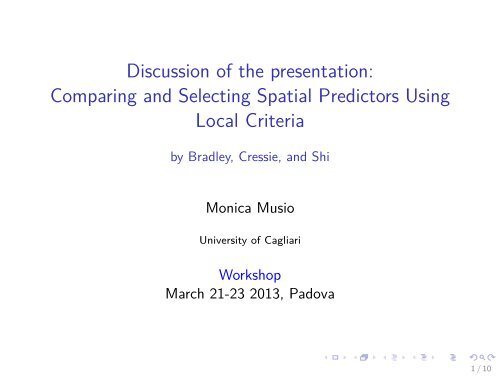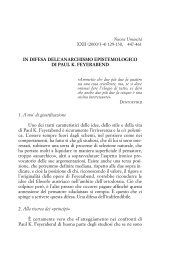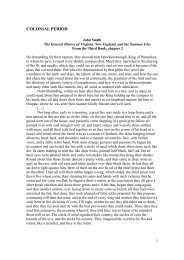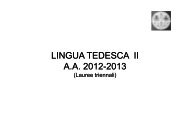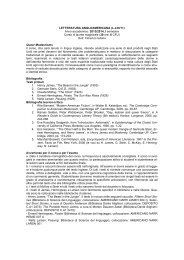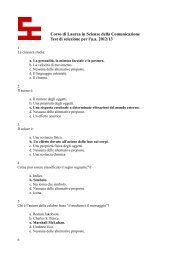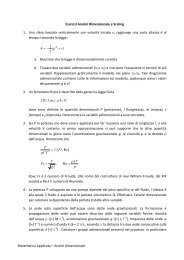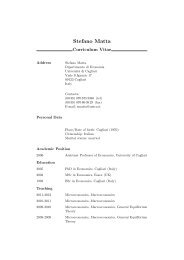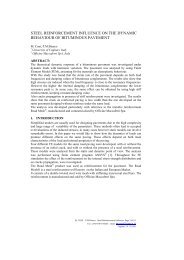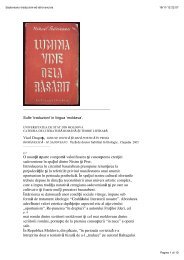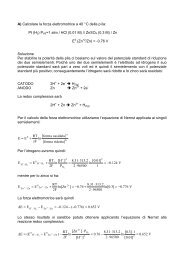Discussion of the presentation: Comparing and Selecting Spatial ...
Discussion of the presentation: Comparing and Selecting Spatial ...
Discussion of the presentation: Comparing and Selecting Spatial ...
Create successful ePaper yourself
Turn your PDF publications into a flip-book with our unique Google optimized e-Paper software.
<strong>Discussion</strong> <strong>of</strong> <strong>the</strong> <strong>presentation</strong>:<br />
<strong>Comparing</strong> <strong>and</strong> <strong>Selecting</strong> <strong>Spatial</strong> Predictors Using<br />
Local Criteria<br />
by Bradley, Cressie, <strong>and</strong> Shi<br />
Monica Musio<br />
University <strong>of</strong> Cagliari<br />
Workshop<br />
March 21-23 2013, Padova<br />
1 / 10
Observation process given by<br />
Z(s) = Y (s) + ɛ(s); s ∈ D<br />
where D = {u1,··· ,uN } ⊂ R d is a spatial lattice,<br />
Y (·) is a hidden process <strong>and</strong> ɛ(·) is a measurement-error process<br />
independent <strong>of</strong> Y (·)<br />
◮ Start from an arbitrary set <strong>of</strong> predictors: Traditional<br />
stationary kriging (TSK), smoothing splines (SSP),<br />
negative-exponential distance weighting (EDW), Fixed Rank<br />
Kriging (FRK), a modified predictive processes approach<br />
(MPP), a stochastic partial differential equation approach<br />
(SPD) <strong>and</strong> lattice kriging (LTK)<br />
◮ Choose between <strong>the</strong> various predictors separately at each site,<br />
using possibly different predictors in different places. At each<br />
site some measure <strong>of</strong> predictive performance is optimised.<br />
2 / 10
◮ Local squared validation error:<br />
LSVE (k) (ui,Z trn ,H val ) =<br />
1<br />
|H val (ui)|<br />
<br />
s∈H val (ui)<br />
(Z(s)− Y (k) (s,Z trn )) 2<br />
k ∗ (ui,Z trn ,H val ) = argmin{LSVE (k) (ui,Z trn ,H val ),k = 1,··· ,K}<br />
Locally selected predictor<br />
Y LSP = ( Y (k∗ ) ,i = 1,··· ,N ) ′<br />
◮ Empirical deviance Information criterion (Bradley, Cressie <strong>and</strong> Shi<br />
(2013))<br />
3 / 10
Very pragmatic approach, aiming to improve predictive<br />
performance<br />
◮ These spatial predictors are <strong>of</strong>ten derived from different<br />
assumptions on <strong>the</strong> stochastic process, or may be deterministic<br />
◮ They can be regarded as approximations <strong>of</strong> <strong>the</strong> underlying<br />
r<strong>and</strong>om field<br />
◮ All <strong>the</strong>se methods sacrifice some important information in <strong>the</strong><br />
data in order to gain computational efficiency<br />
4 / 10
◮ <strong>Selecting</strong> a single predictor from some class <strong>of</strong> predictors does<br />
not take prediction uncertainty into account<br />
◮ Natural extension: instead <strong>of</strong> selecting a single predictor at<br />
each site, assign a weight to each predictor at each site <strong>and</strong><br />
consider a new hybrid local predictor given by <strong>the</strong> weighted<br />
average <strong>of</strong> all local predictors:<br />
˜Y =<br />
K<br />
ωj Y (j)<br />
j=1<br />
e.g. using Buckl<strong>and</strong> et al. (1997) measure <strong>of</strong> predictive<br />
performance, Ij:<br />
ωj =<br />
exp(−Ij/2)<br />
Kk=1 exp(−Ik/2) .<br />
5 / 10
Ano<strong>the</strong>r idea:<br />
◮ in a Bayesian framework: use strictly proper scoring rules to<br />
evaluate probabilistic predictions in <strong>the</strong> form <strong>of</strong> a predictive<br />
distribution.<br />
◮ Scoring rules provide a summary measure for evaluating a<br />
probabilistic prediction given <strong>the</strong> predictive distribution <strong>and</strong><br />
<strong>the</strong> observed outcome.<br />
◮ Can use different scoring rules for different purposes.<br />
◮ Several different scoring rules can be used to compare locally<br />
<strong>the</strong> ability <strong>of</strong> c<strong>and</strong>idate predictors.<br />
6 / 10
Example:<br />
◮ Z(·) is a discrete process , π (k) (s) = {π1(s),··· ,πJ (s)} is <strong>the</strong><br />
posterior predictive distribution <strong>of</strong> predictor k at s,<br />
k = 1,··· ,K<br />
◮ we can compare <strong>the</strong> predictors locally in terms <strong>of</strong> mean score<br />
S = <br />
s∈H val (ui)<br />
◮ Quadratic: S(z,π) = J j=1 π 2 j − 2πz<br />
◮ Spherical: S(z,π) = −<br />
πz<br />
( J j=1 π2 j )1/2<br />
◮ Logarithmic: S(z,π) = −lnπz<br />
S(z(s),π(s))<br />
|H val (ui)|<br />
(Dawid <strong>and</strong> Musio (2013); Finley, Banerjee <strong>and</strong> McRoberts (2009),<br />
Gneiting <strong>and</strong> Raftery (2007))<br />
7 / 10
Continuous case: consider a local scoring rule<br />
◮ log score<br />
S(z,π) = −lnπ(z)<br />
◮ Hyvärinen score (Parry et al. (2012))<br />
∇ = (∂/∂z j ), ∆ = k j=1 ∂ 2 /(∂z j ) 2<br />
S(z,π) = ∆lnπ(z) + 1<br />
2 |∇lnπ(z)|2 = ∆ π(z)<br />
π(z)<br />
you can compare <strong>the</strong> predictors locally in terms <strong>of</strong> mean score<br />
S = <br />
s∈H val (ui)<br />
S(z(s),π(s))<br />
|H val (ui)|<br />
8 / 10
The proposed method used only estimated means, not variances:<br />
LSVE (k) (ui,Z trn ,H val ) ∝ <br />
s∈H val (ui)<br />
(Z(s) − Y (k) (s,Z trn )) 2<br />
If we have an estimate v(s) <strong>of</strong> <strong>the</strong> variance <strong>of</strong> Z at each validation<br />
site s, we could use it to weight <strong>the</strong> terms:<br />
LSVE (k) (ui,Z trn ,H val ) ∝ <br />
s∈H val (ui)<br />
— but this is not a proper scoring rule!<br />
Instead, use<br />
<br />
s∈H val (ui)<br />
(Dawid <strong>and</strong> Sebastiani, 1999)<br />
which is!<br />
(Z(s) − Y (k) (s,Z trn )) 2<br />
v(s)<br />
(Z(s) − Y (k) (s,Ztrn )) 2<br />
+ lnv(s)<br />
v(s)<br />
9 / 10
Bibliography<br />
◮ Bradley, J. R., Cressie, N., <strong>and</strong> Shi, T. (2013). Local<br />
spatial-predictor selection. In Proceedings <strong>of</strong> <strong>the</strong> 2012 Joint<br />
Statistical Meetings, forthcoming. Alex<strong>and</strong>ria, VA: American<br />
Statistical Association<br />
◮ Buckl<strong>and</strong>, S.T., Burnhamn, K.P. <strong>and</strong> Augustin N.H. (1997). Model<br />
Selection: An Integral Part <strong>of</strong> Inference. Biometrics, 53, 603-618<br />
◮ Dawid, A. P.,Musio, M. (2013). Estimation <strong>of</strong> spatial processes<br />
using local scoring rules, AStA, 97, 2, 173-179<br />
◮ Dawid, A. P. <strong>and</strong> Sebastiani, P. (1999). Coherent dispersion criteria<br />
for optimal experimental design. Ann. Statist. 27, 65–81.<br />
◮ Finley A.O., Banerjee S. <strong>and</strong> McRoberts, R. (2009). Hierachical<br />
spatial models for predicting tree species assemblages across large<br />
domains. Annals <strong>of</strong> Applied Statistics, 3, 1052-1079<br />
◮ Gneiting, T., Raftery, A.E. (2007). Strictly proper scoring rules,<br />
prediction, <strong>and</strong> estimation. Journal <strong>of</strong> <strong>the</strong> American Statistical<br />
Association, 102, 359-378<br />
◮ Parry, M. F., Dawid, A. P., <strong>and</strong> Lauritzen, S. L. (2012). Proper<br />
local scoring rules. Annals <strong>of</strong> Statistics, 40, 561-92<br />
10 / 10


